clutch GMC SIERRA 1995 Owners Manual
[x] Cancel search | Manufacturer: GMC, Model Year: 1995, Model line: SIERRA, Model: GMC SIERRA 1995Pages: 488, PDF Size: 26.01 MB
Page 74 of 488
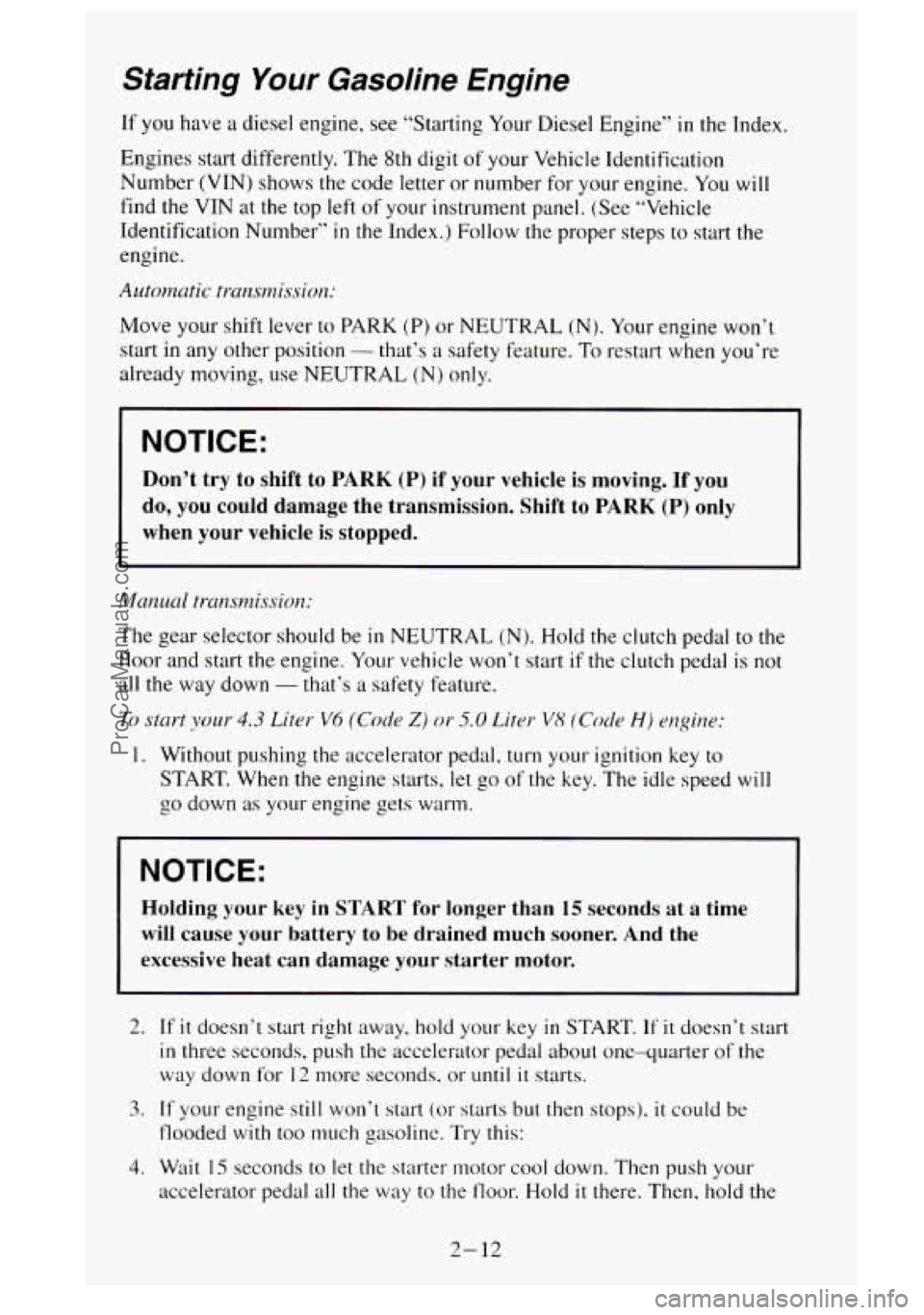
Starting Your Gasoline Engine
If you have a diesel engine, see “Starting Your Diesel Engine” in the Index.
Engines start differently. The 8th digit of your Vehicle Identification
Number (VIN) shows the code letter or number for your engine.
You will
find the
VIN at the top left of your instrument panel. (See “Vehicle
Identification Number”
in the Index.) Follow the proper steps to start the
engine.
Automatic trunsnaission:
Move your shift lever to PARK (P) or NEUTRAL (N). Your engine won’t
start
in any other position - that’s a safety feature. To restart when you’re
already moving, use NEUTRAL
(N) only.
NOTICE:
Don’t try to shift to PARK (P) if your vehicle is moving. If you
do, you could damage the transmission. Shift to
PARK (P) only
when your vehicle
is stopped.
The gear selector should be in NEUTRAL (N). Hold the clutch pedal to the
floor and start the engine. Your vehicle won’t start
if the clutch pedal is not
all the way down
- that’s a safety feature.
To start ymr 4.3 Liter V6 (Code Z) or 5.0 Liter V8 (Code H) engine:
1. Without pushing the accelerator pedal, turn your ignition key to
START. When the engine starts, let go of the key. The idle speed will
go down as your engine gets warm.
NOTICE:
Holding your key in START for longer than 15 seconds at a time
will cause your battery to be drained much sooner. And the
excessive heat can damage your starter motor.
2. If it doesn’t start right away, hold your key in START. If it doesn’t start
in three seconds, push the accelerator pedal about one-quarter of the
way down for
12 more seconds, or until it starts.
3. If your engine still won’t start (or starts but then stops), it could be
flooded
with too much gasoline. Try this:
4. Wait 15 seconds to let the starter motor cool down. Then push your
accelerator pedal all the way to the floor. Hold
it there. Then, hold the
2- 12
ProCarManuals.com
Page 77 of 488
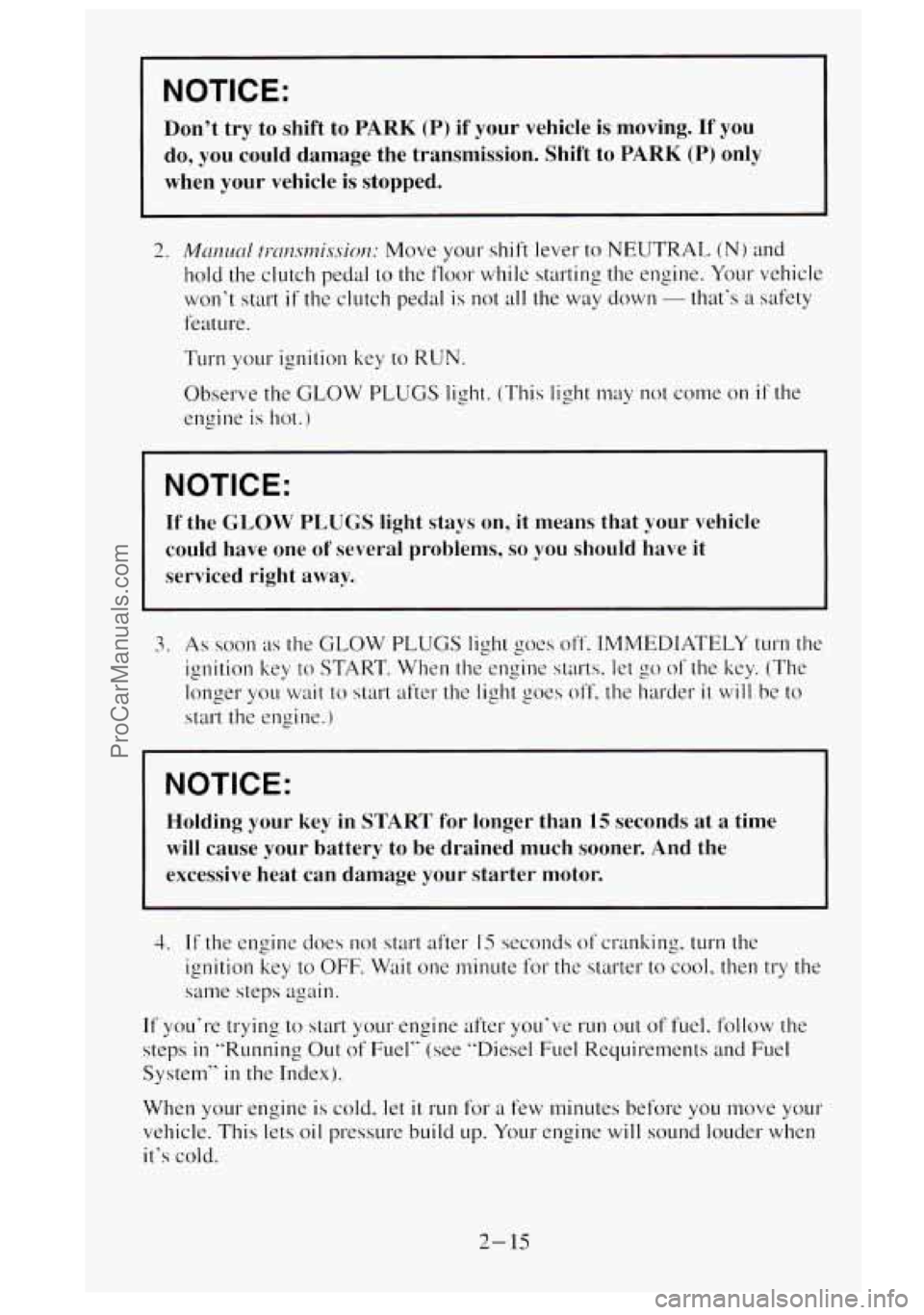
NOTICE:
Don't try to shift to PARK (P) if your vehicle is moving. If you
do, you could damage the transmission. Shift to
PARK (P) only
when your vehicle is stopped.
2. MmLwl ~I-~~CZ.SI~~~.YS~~CZ: Move your shift lever to NEUTRAL (N) and
hold the clutch pedal
to the floor while starting the engine. Your vehicle
won't start
if the clutch pedal is not all the wlay down - that's a safety
feature.
Turn your ignition key to
RUN.
Observe the GLOW PLUGS light. (This light may not come on if the
engine is hot.)
NOTICE:
If the GLOW PLUGS light stays on, it means that your vehicle
could have one
of several problems, so you should have it
serviced right away.
3. As soon as the GLOW PLUGS light goes off. IMMEDIATELY turn the
ignition key
to START. When the engine starts. let go of the key. (The
longer you wait to start after the light goes
off, the harder it will be to
start the engine.)
NOTICE:
Holding your key in START for longer than 15 seconds at a time
will cause your battery to
be drained much sooner. And the
excessive heat can damage your starter motor.
4. If the engine does not start after IS seconds of cranking. turn the
ignition key to OFF. Wait one minute
for the starter to cool. then try the
same steps again.
If you're trying to start your engine after you've run out of fuel. follocv the
steps
in "Running Out of Fuel" (see "Diesel Fuel Requirements and Fuel
System"
in the Index).
When
YOLI~ engine is cold. let it run for a few minutes before you move your
vehicle. This lets oil pressure build
up. Your engine will sound louder when
it's cold.
2- 15
ProCarManuals.com
Page 84 of 488
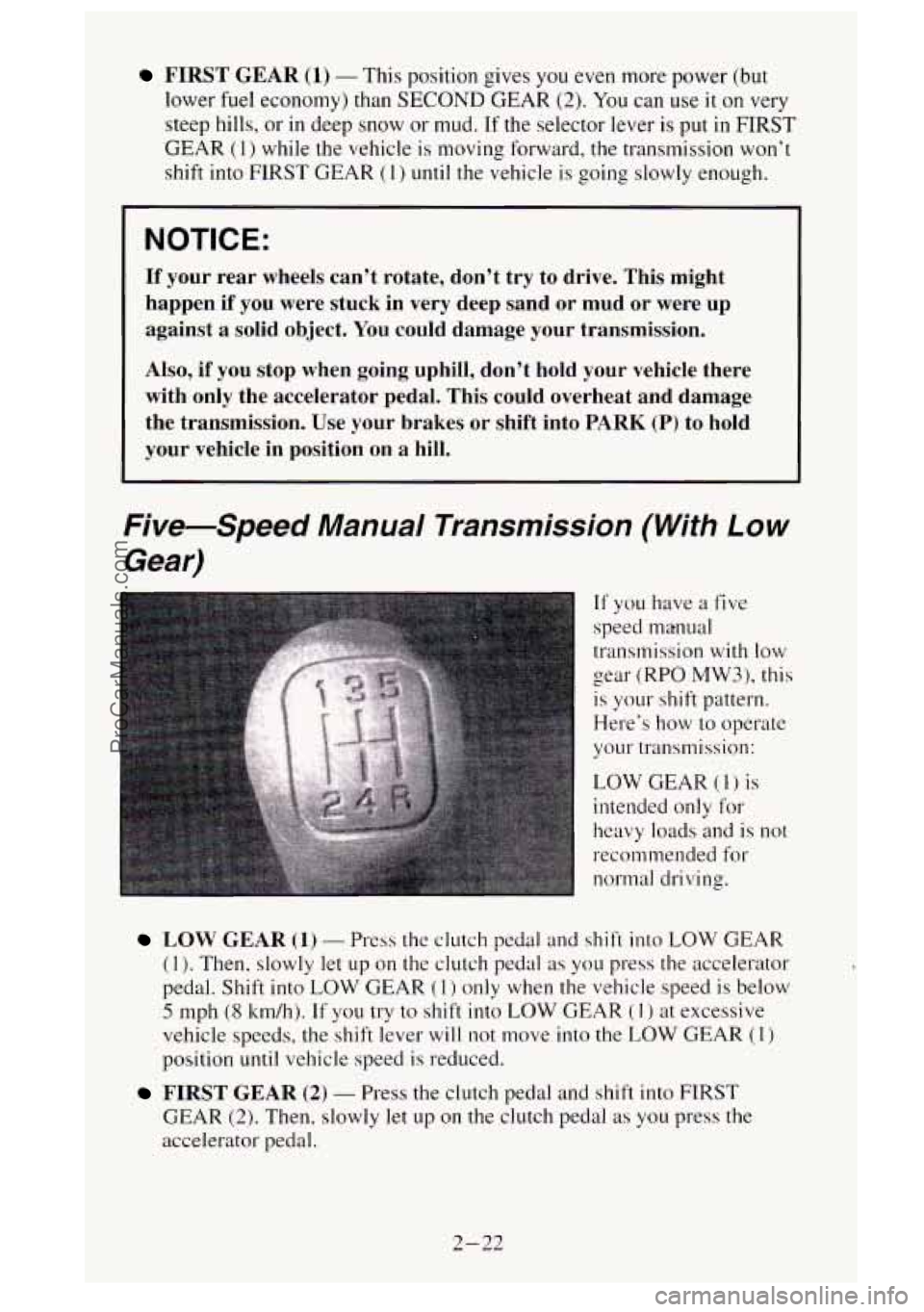
FIRST GEAR (1) - This position gives you even more power (but
lower
fuel economy) than SECOND GEAR (2). You can use it on very
steep hills, or in deep snow or mud. If the selector lever is put in FIRST
GEAR (1) while the vehicle is moving forward, the transmission won’t
shift into FIRST GEAR
(1) until the vehicle is going slowly enough.
NOTICE:
If your rear wheels can’t rotate, don’t try to drive. This might
happen if you were stuck in very deep sand
or mud or were up
against a solid object.
You could damage your transmission.
Also, if you stop when going uphill, don’t hold your vehicle there
with only the accelerator pedal. This could overheat and damage
the transmission.
Use your brakes or shift into PARK (P) to hold
your vehicle in position on a hill.
Five-Spa-ld Manual Transmission (With Low
Gear)
If you have a five
speed manual
transmission with
low
gear (RPO MW3), this
is your shift pattern.
Here’s how to operate
your transmission:
LOW GEAR (1) is
intended only for
heavy loads and is
not
recommended for
normal driving.
LOW GEAR (1) - Press the clutch pedal and shift into LOW GEAR
(1). Then, slowly let up on the clutch pedal as you press the accelerator
pedal. Shift into
LOW GEAR (1) only when the vehicle speed is below
5 mph (8 km/h). If you try to shift into LOW GEAR (I ) at excessive
vehicle speeds, the shift lever
will not move into the LOW GEAR (1)
position until vehicle speed is reduced.
FIRST GEAR (2) - Press the clutch pedal and shift into FIRST
GEAR (2). Then, slowly let up on the clutch pedal as you press the
accelerator pedal.
2-22
ProCarManuals.com
Page 85 of 488
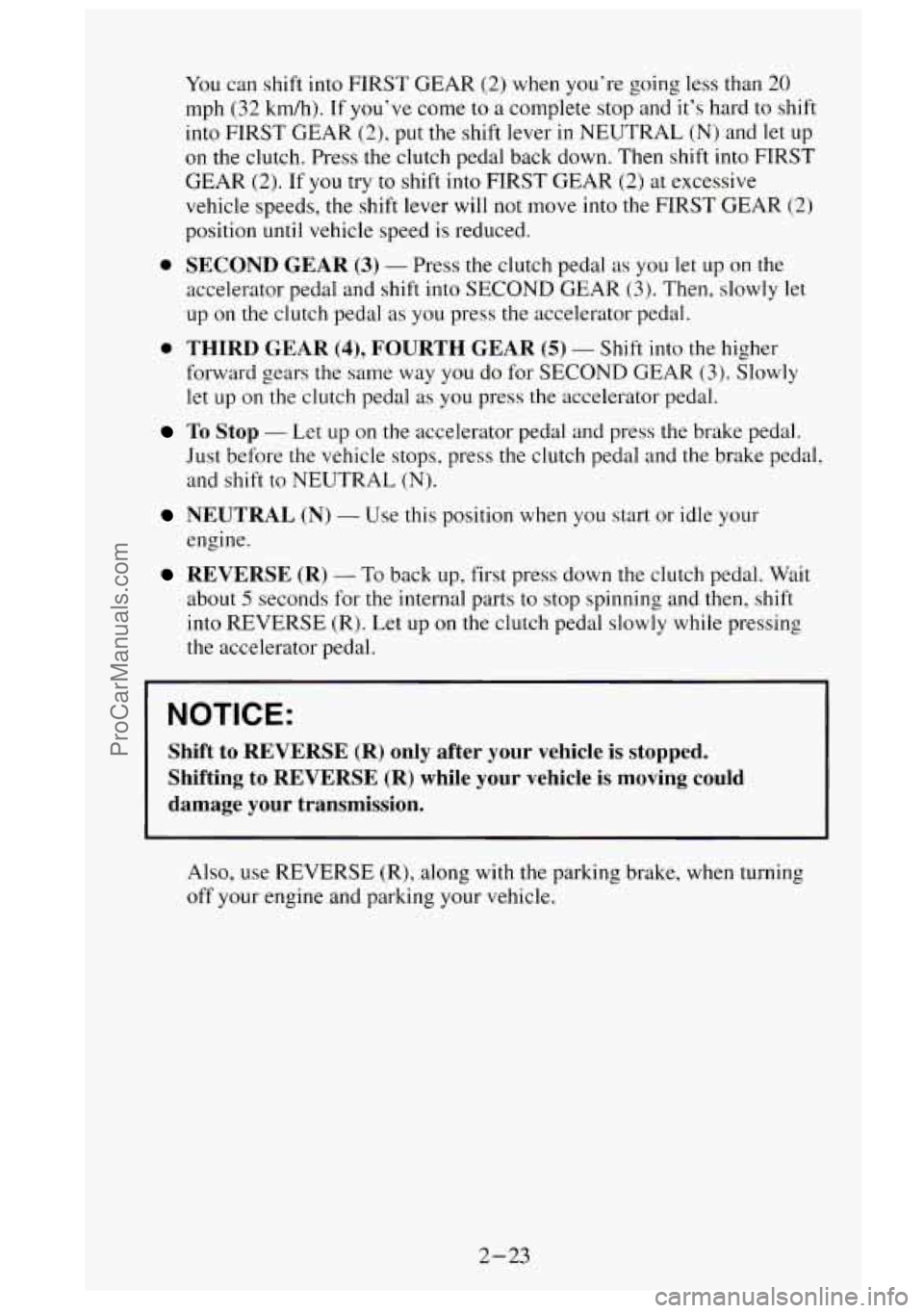
You can shift into FIRST GEAR (2) when you’re going less than 20
mph (32 kmh). If you’ve come to a complete stop and it’s hard to shift
into FIRST GEAR
(2), put the shift lever in NEUTRAL (N) and let up
on the clutch. Press the clutch pedal back down. Then shift into FIRST
GEAR
(2). If you try to shift into FIRST GEAR (2) at excessive
vehicle speeds, the shift lever will not move into the FIRST GEAR
(2)
position until vehicle speed is reduced.
0 SECOND GEAR (3) - Press the clutch pedal as you let up on the
accelerator pedal and shift into SECOND GEAR
(3). Then, slowly let
up on the clutch pedal as you press
the accelerator pedal.
0 THIRD GEAR (4), FOURTH GEAR (5) - Shift into the higher
forward gears
the same way you do for SECOND GEAR (3). Slowly
let up on the clutch pedal as you press the accelerator pedal.
To Stop - Let up on the accelerator pedal and press the brake pedal.
Just before
the vehicle stops, press the clutch pedal and the brake pedal,
and shift to NEUTRAL
(N).
NEUTRAL (N) - Use this position when you start or idle your
engine.
REVERSE (R) - To back up, first press down the clutch pedal. Wait
about
5 seconds for the internal parts to stop spinning and then, shift
into REVERSE (R). Let up
on the clutch pedal slowly while pressing
the accelerator pedal.
NOTICE:
Shift to REVERSE (R) only after your vehicle is stopped.
Shifting to
REVERSE (R) while your vehicle is moving could
damage your transmission.
Also, use REVERSE (R), along with the parking brake, when turning
off your engine and parking your vehicle.
2-23
ProCarManuals.com
Page 86 of 488

Five Speed Manual Transmission (Without
Low Gear)
6 If you have a five
speed manual
transmission without
low gear
(RPO MG5),
this is your shift
pattern. Here’s how to
operate your
transmission:
FIRST GEAR (1) - Press the clutch pedal and shift into FIRST
GEAR
(1). Then, slowly let up on the clutch pedal as you press the
accelerator pedal.
You can shift into FIRST GEAR (1 ) when you’re going less than 20
mph (32 kdh). If you’ve come to a complete stop and it‘s hard to shift
into FIRST GEAR
(1). put the shift lever in NEUTRAL (N) and let up
on the clutch. Press the clutch pedal back down. Then shift into FIRST
GEAR
(1).
SECOND GEAR (2) - Press the clutch pedal as you let up on the
accelerator pedal and shift into SECOND GEAR
(2). Then, slowly let
up
on the clutch pedal as you press the accelerator pedal.
THIRD GEAR (3), FOURTH GEAR (4) and FIFTH GEAR (5) -
Shift into THIRD GEAR (3). FOURTH GEAR (4) and FIFTH GEAR
(5) the same way you do for SECOND GEAR (2). Slowly let up on the
clutch pedal
as you press the accelerator pedal.
Just before the vehicle stops, press the clutch pedal and the brake pedal,
and shift to NEUTRAL
(N).
0 To Stop - Let up on the accelerator pedal and press the brake pedal.
NEUTRAL (N) - Use this position when you start or idle your
engine.
REVERSE (R) - To back up, first press down the clutch pedal. Wait
about 5 seconds for the internal parts to stop spinning and then, shift
into REVERSE (R). Let up on the clutch pedal slowly while pressing
the accelerator pedal.
2-24
ProCarManuals.com
Page 88 of 488
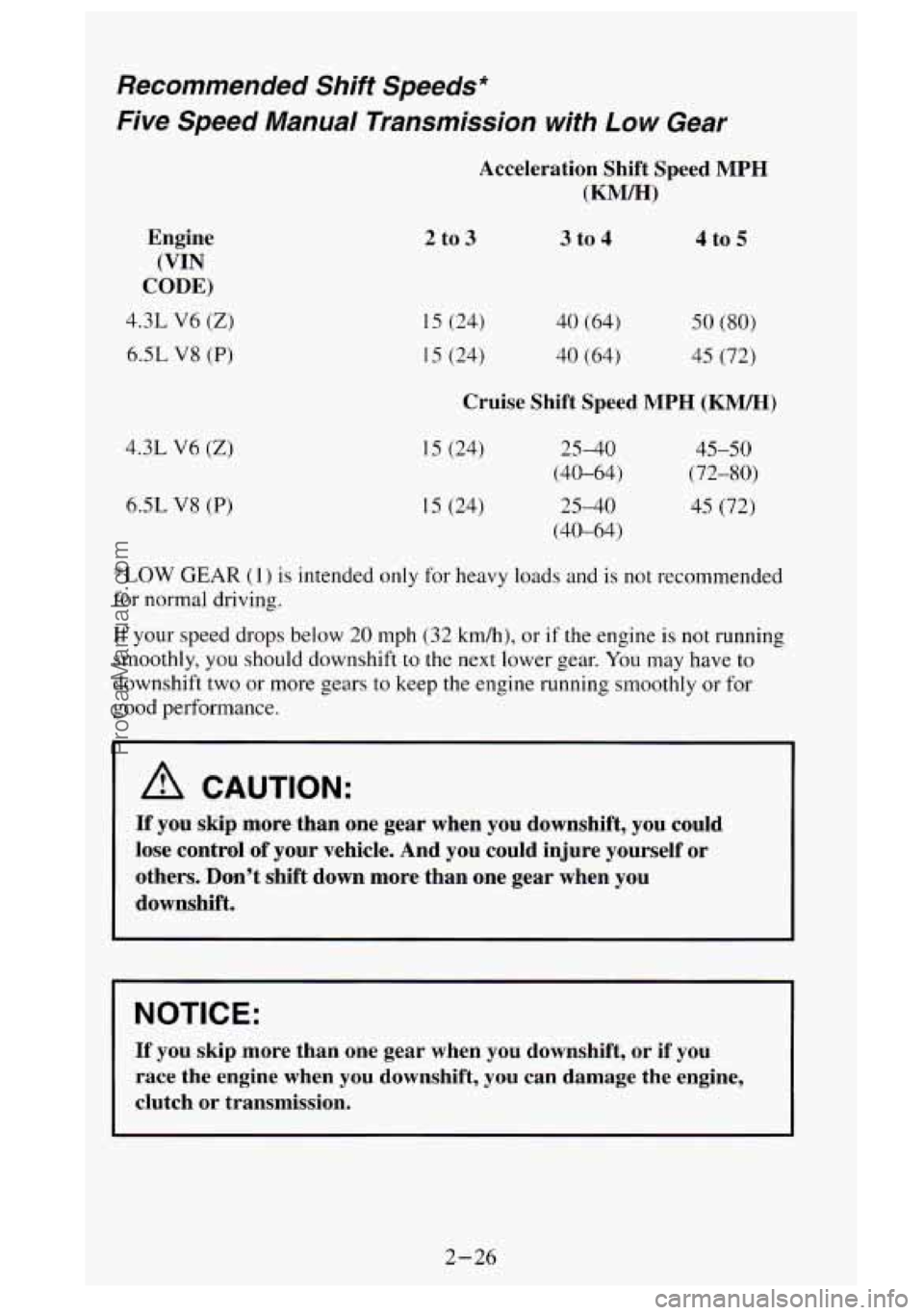
Recommended Shift Speeds*
Five
Speed Manual Transmission with Low Gear
Acceleration Shift Speed MPH
(KW)
Engine
(VIN
CODE)
4.3L V6 (Z)
6.5L V8 (P)
4.3L V6 (Z)
6.SL V8 (P)
2 to 3
15 (24)
1 5 (24)
3 to 4
40 (64)
40 (64)
4 to 5
50 (80)
45 (72)
Cruise Shift Speed MPH (KM/H)
15 (24)
I 5 (24) 25-40
(40-64)
25-40
(40-64) 45-50
(72-80)
45 (72)
*LOW GEAR (1) is intended only for heavy loads and is not recommended
for normal driving.
If your speed drops below 20 mph
(32 km/h), or if the engine is not running
smoothly,
you should downshift to the next lower gear. You may have to
downshift two
or more gears to keep the engine running smoothly or for
good performance.
A CAUTION:
If you skip more than one gear when you downshift, you could
lose control of your vehicle. And you could injure yourself or
others. Don’t shift
down more than one gear when you
downshift.
NOTICE:
If you skip more than one gear when you downshift, or if you
race the engine when you downshift, you can damage the engine,
clutch or transmission.
2-26
ProCarManuals.com
Page 97 of 488
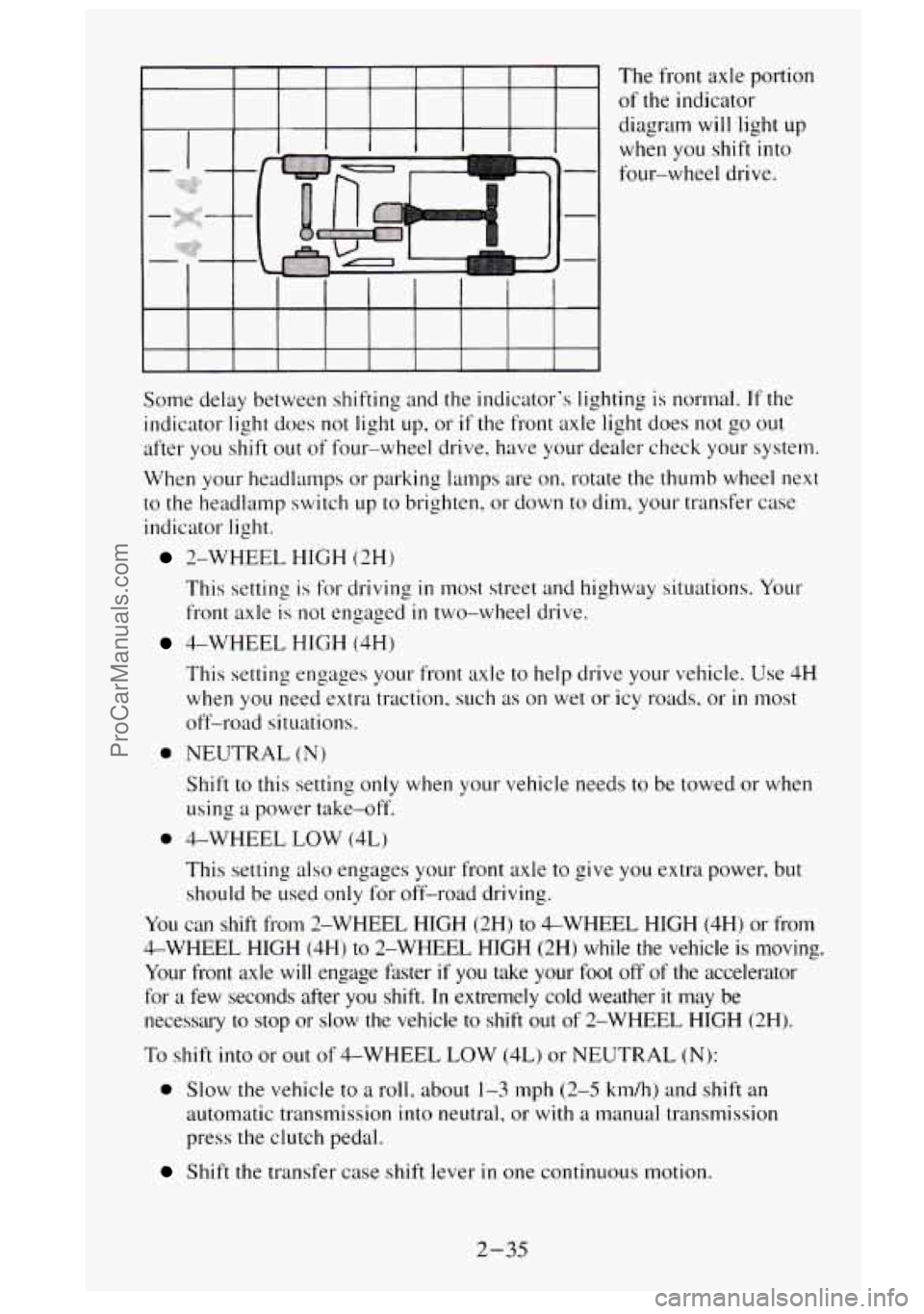
The from axle portion
of the indicator
diagram will light
up
when you shift into
four-wheel drive.
Some delay between shifting and the indicator's lighting is normal.
If the
indicator light does not light
up, or if the front axle light does not go out
after you shift out of four-wheel drive. have your dealer check your system.
When your headlamps or parking lamps are
on, rotate the thumb wheel next
to the headlamp switch up to brighten, or down to dim, your transfer case
indicator light.
2-WHEEL HIGH (2H)
This setting is for driving
in most street and highway situations. Your
front axle is not engaged
in two-wheel drive.
4-WHEEL HIGH (4H)
This setting engages your front axle to help drive your vehicle. Use
4H
when you need extra traction, such as on wet or icy roads. or in most
off-road situations.
0 NEUTRAL (N)
Shift to this setting only when your vehicle needs to be towed or when
using
a power take-off.
0 4-WHEEL LOW (4L)
This setting also engages your front axle to give you extra power, but
should be used only for off-road driving.
You can shift from 2-WHEEL HIGH (2H)
to &WHEEL HIGH (4H) or from
4-WHEEL HIGH (4H) to 2-WHEEL HIGH (2Hj while the vehicle is moving.
Your front axle
will engage faster if you take your foot off of the accelerator
for a few seconds after you shift.
In extremely cold weather it may be
necessary
to stop or slow the vehicle to shift out of 2-WHEEL HIGH (2H).
To shift
into or out of 4-WHEEL LOW (4L) or NEUTRAL (N):
0 Slow the vehicle to a roll. about 1-3 mph (2-5 km/h) and shift an
automatic transmission into neutral,
or with a manual transmission
press the clutch pedal.
Shift the transfer case shift lever in one continuous motion.
2-35
ProCarManuals.com
Page 191 of 488
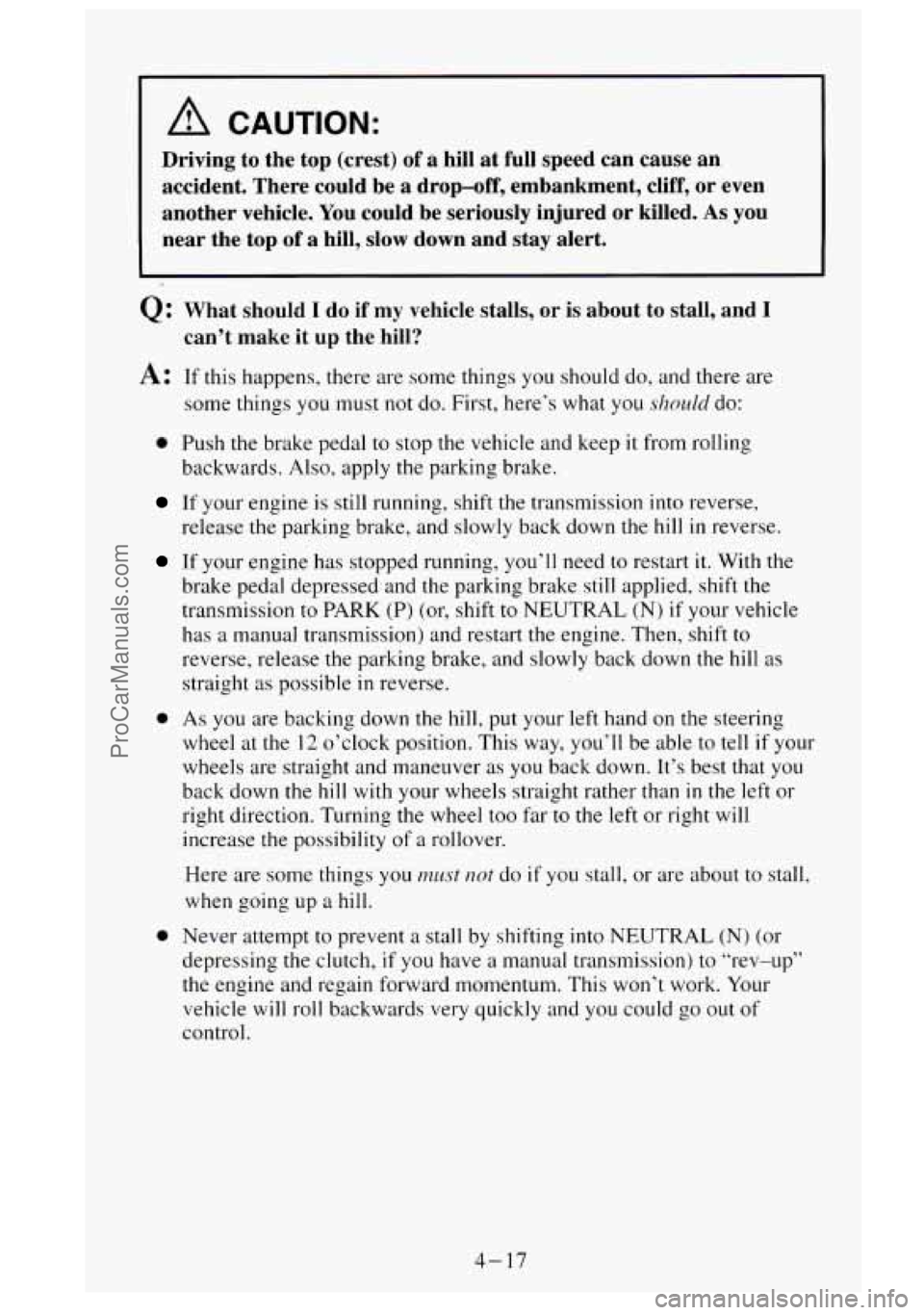
A CAUTION:
Driving to the top (crest) of a hill at full speed can cause an
accident. There could be a drop-off, embankment, cliff, or even
another vehicle. You could be seriously injured
or killed. As you
near the top
of a hill, slow down and stay alert.
Q: What should I do if my vehicle stalls, or is about to stall, and I
A: If this happens, there are some things you should do, and there are
some things you must not do. First, here’s what you
shoclld do:
can’t make it up the hill?
0 Push the brake pedal to stop the vehicle and keep it from rolling
backwards. Also, apply the parking brake.
If your engine is still running, shift the transmission into reverse,
release the parking brake, and slowly back down the
hill in reverse.
If your engine has stopped running, you’ll need to restart it. With the
brake pedal depressed and the parking brake still applied, shift the
transmission to PARK (P) (or, shift to NEUTRAL
(N) if your vehicle
has a manual transmission) and restart the engine. Then, shift
to
reverse, release the parking brake, and slowly back down the hill as
straight
as possible in reverse.
0 As you are backing down the hill, put your left hand on the steering
wheel at the
12 o’clock position. This way, you’ll be able to tell if your
wheels are straight and maneuver
as you back down. It’s best that you
back down the hill with your wheels straight rather than in the left or
right direction. Turning the
wheel too far to the left or right will
increase the possibility
of a rollover.
Here are some things you
must mt do if you stall, or are about to stall,
when going
up a hill.
0 Never attempt to prevent a stall by shifting into NEUTRAL (N) (or
depressing the clutch,
if you have a manual transmission) to ”rev-up”
the engine and regain forward momentum. This won’t work. Your
vehicle will roll backwards very quickly and
you could go out of
control.
4-’17
ProCarManuals.com
Page 193 of 488

If you decide you can go down a hill safely, then try to keep your vehicle
headed straight down, and use a low gear. This way, engine drag can help
your brakes and they won’t have to do all
the work. Descend slowly,
keeping your vehicle under control at all times.
A CAUTION:
Heavy braking when going down a hill can cause your brakes to
overheat and fade. This could cause
loss of control and a serious
accident. Apply the brakes lightly when descending
a hill and
use a low gear to keep vehicle speed under control.
Q: Are there some things I should not do when driving down a hill?
A: Yes! These are important because if you ignore them you could lose
control and have a serious accident.
When driving downhill, avoid turns that take you across the incline of
the hill. A hill that’s not too steep to drive down may be too steep to
drive across.
You could roll over if you don’t drive straight down.
Never go downhill with the transmission in NEUTRAL (N) , or with
the clutch pedal depressed in a manual shift
. This is called
“free-wheeling.” Your brakes will have to do all the work and could
overheat and fade.
Q: Am I likely to stall when going downhill?
A: It’s much more likely to happen going uphill. But if it happens going
downhill, here’s what
to do.
0 Stop your vehicle by applying the regular brakes. Apply the parking
brake.
Shift to PARK (P) (or to Neutral with the manual transmission) and,
while still braking, restart the engine.
down.
Shift back to a low gear, release the parking brake, and drive straight
If the engine won’t start, get out and get help.
4- 19
ProCarManuals.com
Page 209 of 488
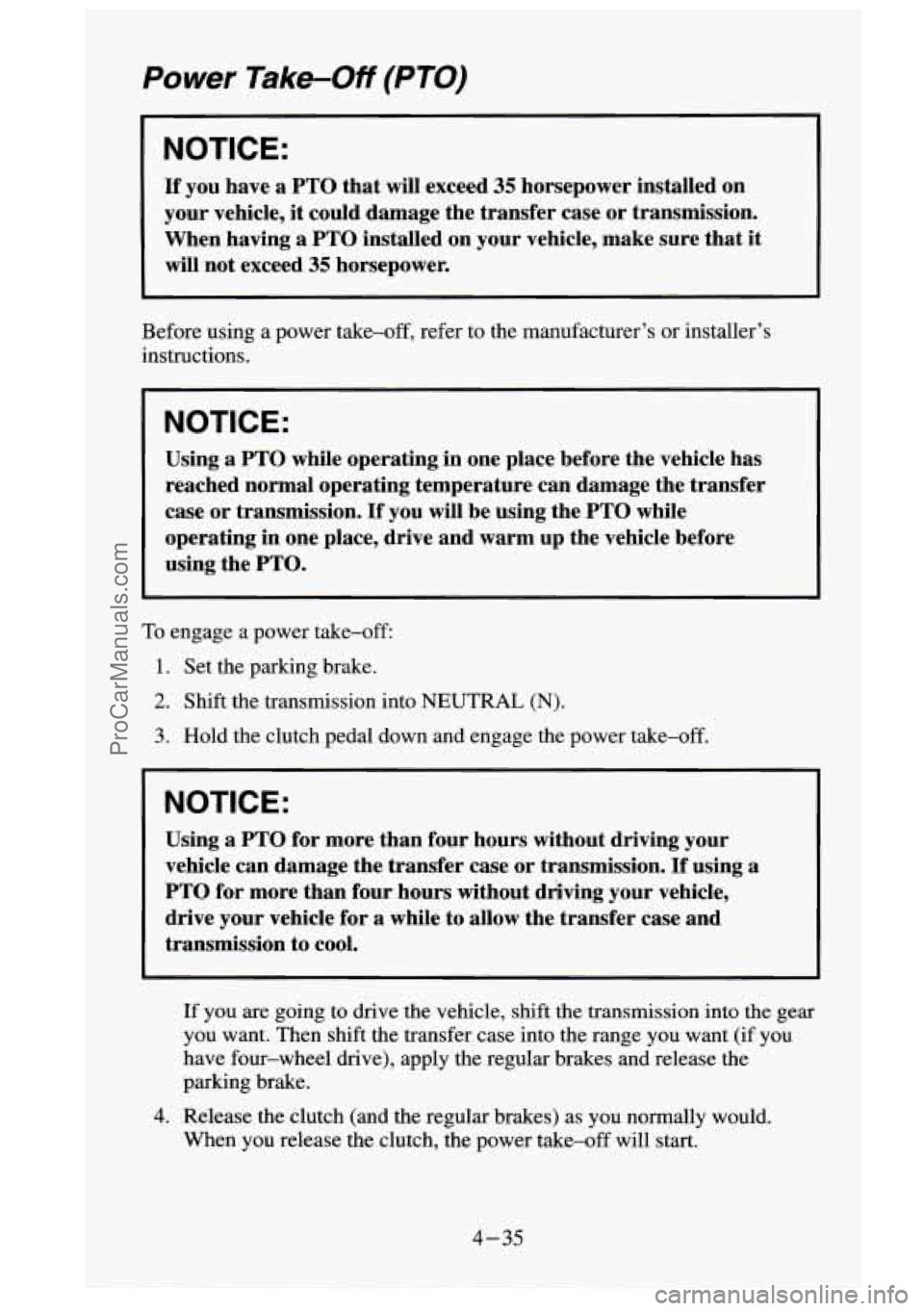
Power Take-Off (PTO)
NOTICE:
If you have a PTO that will exceed 35 horsepower installed on
your vehicle, it could damage the transfer case or transmission.
When having
a PTO installed on your vehicle, make sure that it
will not exceed 35 horsepower.
Before using a power take-off, refer to the manufacturer’s or installer’s
instructions.
NOTICE:
Using a PTO while operating in one place before the vehicle has
reached normal operating temperature can damage the transfer
case or transmission.
If you will be using the PTO while
operating in one place, drive and warm up the vehicle before
using the PTO.
To engage a power take-off
1. Set the parking brake.
2. Shift the transmission into NEUTRAL (N).
3. Hold the clutch pedal down and engage the power take-off.
I NOTICE:
Using a PTO for more than four hours without driving your
vehicle can damage the transfer case or transmission.
If using a
PTO for more than four hours without dr$ving your vehicle,
drive your vehicle for
a while to allow the transfer case and
transmission to cool.
If you are going to drive the vehicle, shift the transmission into the gear
you want. Then shift the transfer case into the range you want (if you
have four-wheel drive), apply the regular brakes and release the
parking brake.
4. Release the clutch (and the regular brakes) as you normally would.
When you release the clutch, the power take-off will start.
4-35
ProCarManuals.com